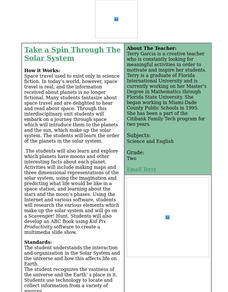Curated OER
Mars: Off the Charts--Until You Put It There
Students explore the night sky and make illustrations which are shared in class the next day. Distinctions are made between the stars and the planets and views of the constellations for the season are made available. The work of early...
Curated OER
How Long Would It Take To Travel To the Stars?
Students consider the amount of time that it would take to get to the star, Sirius using various modes of transportation, some practical and some whimsical. The practicality of physically going to another star system is explored in this...
Curated OER
Palm use in Astronomy
Learners identify and recall common constellations by using a palm pilot with astronomy software. Students will use their Palm to assist them in correctly identifying constellations using a telescope.
Curated OER
Observing Mars in the Night Sky
High schoolers compare and contrast the orbits of Earth and Mars, locate the planet Mars, and diagram its retrograde motion.
Curated OER
Finding the Pole Star
Students study the constellations fo the Big Dipper and Cassiopeia and their use in finding the Pole Star. They realize that other celestial objects--Sun, Moon and planets--share the rotation (and hence rise and set), even though their...
Curated OER
Take a Spin Through the Solar System
Second graders participate in a variety of activities to explore the Solar System in this unit.
Curated OER
The Mystery Constellation
Learners decipher two teacher chosen mystery constellations a month. They listen to stories, explain what they know about constellations and name the mystery constellation.
Harvard University
Harvard Smithsonian Center for Astrophysics: The Constellations
Based on images from the Chandra X-Ray Observatory, this is an excellent glossary of all the constellations, including the ones that make up the Zodiac. Find images, photographs, and an excellent background narratives concerning each...
University of Wisconsin
University of Wisconsin: The Constellations and Their Stars
An excellent site dedicated to the constellations and information about the objects which make them up. Contains a great deal of information about various stars, galaxies and other objects, as well as details on how best to observe them.
University of California
Cse: What's Your Sign? The Science Behind the Zodiac
This paper presents the explanation behind the Zodiac signs. It discusses motions of celestial objects, the Plane of the Ecliptic, and the constellations of the Zodiac.
Science Buddies
Science Buddies: Changing Constellations
Do you like to look up into the night sky? There are so many stars, it can be mind boggling. Some ancient people marked time by the changes in star patterns. We still use changes in constellation patterns to mark astronomical time. This...
American Association of Physics Teachers
Com Padre Digital Library: Open Source Physics: Local Coordinates Model
This astronomy simulation presents stars in their Altitude/Azimuth coordinates serving as an introduction to the celestial globe and equatorial coordinates.
Other
Sloan Digital Sky Survey: Sky Map
This astronomical survey by the Sloan Digital Sky Survey is poised to be one of the most ambitious ever undertaken. When completed, it will provide detailed images covering more than a quarter of the sky, and almost a million galaxies...
Other
Constellations Web Page: The Constellations
Information about 88 constellations, including the myths associated with them and details of the major astronomical objects that are part of them.
University of Oxford (UK)
Museum of the History of Science, Oxford: Tycho Brahe
This site contains information about Tycho Brahe as well as many pictures of him and his diagrams of the universe as he saw it.
Other
Sea and Sky: The Constellations
Is that a lion in the sky? Find out what the constellations are, how they were named, and when stargazers might see specific ones throughout the year.
Other
Sea and Sky: Celestial Objects
Empty space in outer space is not truly empty. Celestial objects fill the space not occupied by planets, stars, and such. This resource identifies these objects and further explains their existence.
Enchanted Learning
Enchanted Learning: Zoom Astronomy: All About Space
A fantastic collection of information about the solar system. Includes information on all of the planets, the moon, the sun, asteroids, comets, meteoroids, and stars. Also find puzzles, a dictionary, quizzes, classroom activities, and...
Globio
Glossopedia: Stars
Many of the objects you can see in the night sky are stars, large objects in space that produce light. Our galaxy, the Milky Way, contains more than 100 billion stars. Stars are so far away that their light does not reach us for years....
Utah Education Network
Uen: A Moon With a View
Understand the rotation of the earth and the appearance of movement of other bodies in the sky.
PBS
Pbs Learning Media: Meteor Showers
This video segment adapted from NASA uses animation to illustrate the properties of meteor showers and comets. Included is are visualizations of a comet's tail and of Earth passing through a debris stream left behind by meteoroids.
Cosmos 4 kids
Cosmos4 Kids: Long, Long Ago
This site explores constellations found in the sky. Watch a video on the site that explores the constellations found in the winter sky.
E-learning for Kids
E Learning for Kids: Science: Antarctica: Describe the Life Cycle of Stars
Discover the stars with Peter. At his mom's research center, help Peter learn constellations and learn about characteristics of stars.
National Endowment for the Humanities
Neh: Edsit Ement: Galileo: Revealing the Universe
In this lesson plan, students will consider "Galileo: Revealing the Universe." The plan includes worksheets and other student materials that can be found under the resource tab.
























